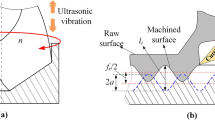Abstract
High-speed circuit boards are created to meet the high-speed signal transmission requirements of 5G communication technology, but the non-polar resins, flat glass fibers, and multiple and hard fillers used for this purpose have posed new challenges to their micro-hole processing. The quality of micro-hole has always been a decisive factor in board performance. Therefore, this paper aims at proposing a new processing method for improving the micro-hole drilling quality of high-speed circuit boards. By establishing an ultrasonic-assisted drilling tool motion model, analyzing the changes in drilling method, material deformation, chip breakage, and chip removal during ultrasonic-assisted drilling of printed circuit boards, the influence mechanism on micro-hole quality during ultrasound-assisted drilling is studied prudently. Besides, an experimental platform for ultrasonic-assisted drilling is designed and built, and single-factor experiments for verification of ultrasonic effects, optimization of drilling parameters, and orthogonal experiments for ultrasonic-assisted drilling of high-speed circuit boards are conducted on this platform. The experimental results show that the loading of ultrasonic vibration has made an obvious improvement on several machining defects including hole wall roughness, entrance burr, and nail head in micro-hole drilling of high-speed circuit boards. In addition, the influence order of each processing parameter and a better combination of them are discovered, which provides a theoretical research basis and instructions for the improvement of micro-hole quality of high-speed circuit boards.




















Similar content being viewed by others
Data availability
All data generated or analyzed during this study are included in the present article.
Code availability
Not applicable.
References
Zhu DT (2019) Discussion on the development of high-speed laminate technology. in Proceedings of the 20th China Copper Clad Technology Symposium. Suzhou, Jiangsu, China
Ko SL, Chang JE, Yang GE (2003) Burr minimizing scheme in drilling. J Mater Process Technol 140(1/3):237–242
Bhandari B, Hong YS, Yoon HS, Moon JS, Pham MQ, Lee GB, Huang YC, Linke BS, Dornfeld DA, Ahn SH (2014) Development of a micro-drilling burr-control chart for PCB drilling. Precis Eng 38(1):221–229
Song YX, Fu LY, Zheng LJ, Yang LP, Wang CY (2012) Characteristics of chip formation in the micro-drilling of multi-material sheets. Int J Mach Tools Manuf 52(1):40–49
Watanabe H, Tsuzaka H, Masuda M (2008) Microdrilling for printed circuit boards (PCBs)—Influence of radial run-out of microdrills on hole quality. Precis Eng 32(4):329–335
Sahoo S, Thakur A, Gangopadhyay S (2016) Application of analytical simulation on various characteristics of hole quality during micro-drilling of printed circuitboard. Mater Manuf Processes 31(14):1927–1934
Wang YS, Zou B, Yin GG (2019) Wear mechanisms of Ti(C7N3)-based cermet micro-drill and machining quality during ultra-high speed micro-drilling multi-layered PCB consisting of copper foil and glass fiber reinforced plastics. Ceram Int 45(18 Pt.A):24578–24593
Shi HY, Liu XW, Lou Y (2019) Materials and micro drilling of high frequency and high speed printed circuit board: a review. Int J Adv Manuf Technol 100(1/4):827–841
Yan B, Li ZY, Zheng LJ (2021) Optimization of carbide microdrilling tool structure for microhole machining of printed circuit board. Cemented Carbide 38(6):9
Zhang CX, Zhang WF, Liu ZJ, Zhang FX (2021) Research status and development trend of rotary ultrasonic drilling process. Mach Build Autom 50(01):1–5
Zhang Y, Kang RK, Liu JT, Zhang YM, Zheng WS, Dong ZG (2017) Review of ultrasonic vibration-assisted drilling technology. J Mech Eng 53(19):33–44
Kumabe J (1985) Precision machining vibratory cutting: fundamentals and applications. Machinery Industry Press, Beijing, pp 1–30
Zhang DY, Wang LJ (1993) Local chip breaking characteristics of vibratory drilling. J Appl Sci 04:337–344
Brehl DE, Dow TA (2008) Review of vibration-assisted machining. Precis Eng-J Int Soc Precis Eng Nanotechnol 32(3):153–172
Ma LJ (2007) Experimental study on the mechanism of axial vibration drilling and its process effect. Jiangsu University: Jiangsu. p. 1–20
Mikhailova N, Onawumi PY, Volkov G, Smirnov I, Broseghini M, Roy A, Petrov Y, and Silberschmidt VV (2019) Ultrasonically assisted drilling in marble. J Sound Vib 460:114880. https://doi.org/10.1016/j.jsv.2019.114880
Baraheni M, Amini S (2018) Feasibility study of delamination in rotary ultrasonic-assisted drilling of glass fiber reinforced plastics. J Reinf Plast Compos 37(1):3–12
Shao Z, Jiang X, Geng D, Liu Y, Zheng W (2021) The interface temperature and its influence on surface integrity in ultrasonic-assisted drilling of CFRP/Ti stacks. Compos Struct 6:113803
Ma GF, Kang RK, Dong ZG (2020) Hole quality in longitudinal-torsional coupled ultrasonic vibration assisted drilling of carbon fiber reinforced plastics. Front Mech Eng 15(4):538–546
Yuan YJ, Wei ZL, Fu B (2020) Design and vibration characteristics analysis of ultrasonic vibration deburring tool head. Mech Eng 04:22–24+27
Liu XL, Chen Y, Wang J, Zhang GF (2019) Deburring of TC4 titanium alloy hole edge by magnetic grinding in combination with electrolysis and rotational ultrasonic vibration. Electroplating Finish | Electroplat Finish 13:680–684
Acknowledgements
This research is supported by the National Natural Science Foundation of China (No. 52075344), and the Science and Technology Innovation Commission Shenzhen (Nos. JSGG2019152602381 and JSGG20200914113603008).
Author information
Authors and Affiliations
Corresponding author
Ethics declarations
Ethics approval
Not applicable.
Consent to participate
Not applicable.
Consent for publication
Not applicable.
Competing interest
The authors declare no competing interests.
Additional information
Publisher's Note
Springer Nature remains neutral with regard to jurisdictional claims in published maps and institutional affiliations.
Rights and permissions
Springer Nature or its licensor (e.g. a society or other partner) holds exclusive rights to this article under a publishing agreement with the author(s) or other rightsholder(s); author self-archiving of the accepted manuscript version of this article is solely governed by the terms of such publishing agreement and applicable law.
About this article
Cite this article
Gao, Z., Shi, H., Tao, S. et al. Study on the mechanism affecting the quality of micro-hole in ultrasonic-assisted drilling of high-speed circuit boards. Int J Adv Manuf Technol 124, 2527–2544 (2023). https://doi.org/10.1007/s00170-022-10638-w
Received:
Accepted:
Published:
Issue Date:
DOI: https://doi.org/10.1007/s00170-022-10638-w




